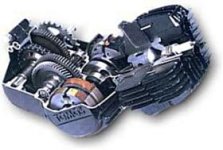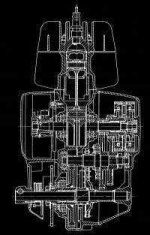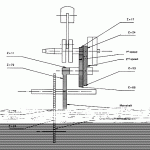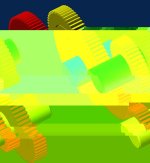Miles said:
John,
I'll try and work out a design, sometime next week.
Not sure about the Nu Vinci.....? It would be less efficient than a hub gear and weigh as much as a hub motor.......
I would not get to hung up about efficiency at the rear wheel like that. Efficiency is very nice at the motor because any wasted energy ends up as heat, which is bad, and puts heavier loads on the batteries.
On a upright bicycle once you get over a certain speed inefficiencies in aerodynamics far far far far outweigh any efficiency lost through drive train. Hell weight doesn't matter that much either. People who spend hundreds of dollars to loose a few ounces on their bikes are completely delusional.
At low speeds weight and efficiency in the drive train matter becuase they are significant and bicyclists operate under their own power... at higher speeds people are aiming at with electric bikes they become such a small matter that it's laughable to worry about it to much. The Nuvinci's drag is noticable on road bikes and on Velomobiles.. but for this sort of application, upright electric bike, it's not really going to be a huge deal. It may be a big deal if your comparing two things with similar performance and price characteristics.. but I wouldn't worry about it at this point.
Here you can see the difference illustrated in a artificial manner:
Well... the espeed page is down, getting a 404 error, but here is the calculator in the Internet Archive...
http://web.archive.org/web/20080213094200/http://www.kreuzotter.de/english/espeed.htm
It's kinda interesting to play around with, but here is something telling....
So say you have a 750 motor.... Put that into the wattage category. Now compare the MTB to the Racing upright bike...
MTB top speed: 29.1 mph
Racing Bike (upright position, hands on tops) top speed: 30.7 mph
So at these speeds the differences in the weight of the bikes (about 9 pounds) and the much lower rolling resistance offered by the high pressure tires amounts to less then 2mph difference.
Now look at the difference in riding position offers:
Racing Bike (lower position, hands on bottoms) top speed: 34.8mph
Racing Bike (superman style): 40 mph
So a simple change in riding position is worth 2-5 times more then high efficiency tires and much lighter weight.
Now with a Velomobile you have very good aerodynamics... Their top speed with 750 watts is: 69.7
I think at that range the calculator is probably loosing a lot of it's accurancy, but hopefully it's good enough to drive the point home.
With pedal power at low speeds on a Road bike being compared back to back with derailers, or with endurance racing were your trying to get as much energy efficiency to the ground as much as possible then the Nuvinci is going to come up short. But otherwise it's not so much.
-------------------------------------------
I think the priorities here are going to be:
- Reliability (complexity is the enemy of reliability)
- Ease of Manufacture
- Cost
- Ease of Maintenance
Then things like Weight and Efficiency are also very important, but I wouldn't sweat it if it's not too bad. The more power your planning on driving through the system the less relevant... a 1Kw motor it's not so important... a 300 watt motor then it's probably very important.






